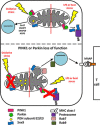Presenting mitochondrial antigens: PINK1, Parkin and MDVs steal the show
- PMID: 27585536
- PMCID: PMC5099861
- DOI: 10.1038/cr.2016.104
Presenting mitochondrial antigens: PINK1, Parkin and MDVs steal the show
Abstract
In a recent paper published in Cell, Matheoud et al. demonstrated that, in response to cellular stress, self-antigens can be extracted from mitochondria via mitochondrial-derived vesicles and presented at the cell surface to trigger an immune response; this pathway, termed mitochondrial antigen presentation (MitAP), is repressed by PINK1 and Parkin. These findings implicate autoimmune mechanisms in Parkinson's disease.
Figures

Comment on
-
Parkinson's Disease-Related Proteins PINK1 and Parkin Repress Mitochondrial Antigen Presentation.Cell. 2016 Jul 14;166(2):314-327. doi: 10.1016/j.cell.2016.05.039. Epub 2016 Jun 23. Cell. 2016. PMID: 27345367
References
-
- Matheoud D, Sugiura A, Bellemare-Pelletier A, et al. Cell 2016; 166:314–327. - PubMed
Publication types
MeSH terms
Substances
LinkOut - more resources
Full Text Sources
Other Literature Sources
Medical

